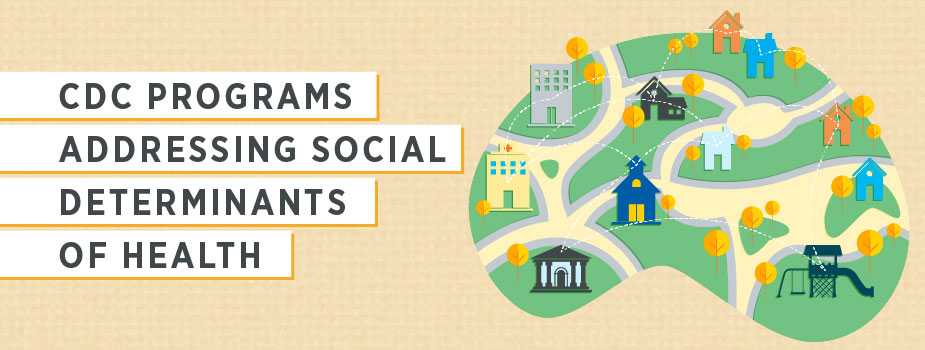CDC Programs Addressing Social Determinants of Health

Programs across CDC recognize the importance of SDOH to the health of populations. These programs work across sectors such as housing, education, and transportation and in partnership with communities, because working together can have a greater health impact than working alone. The following CDC programs specifically include SDOH:
-
Built Environment and Health Initiative: Designing and Building Healthy Places
- This initiative works to improve public health by: linking public health surveillance with community design decisions; improving community design decisions through tools such as Health Impact Assessments ; educating decision makers on the health impact of community design; building partnerships with community design decision makers and their influencers; conducting research to identify the links between health and community design; and translating research into best practices.
-
Childhood Lead Poisoning Prevention Program
- This program aims to prevent childhood lead poisoning and other housing-related health hazards through housing rehabilitation, enforcement of housing and health codes, and partnering with health care experts. This program helps CDC, the Department of Housing and Urban Development, U.S. Environmental Protection Agency, and other agencies reach their goal to eliminate childhood lead poisoning by 2020.
-
National Leadership Academy for the Public's Health (NLAPH)
- NLAPH is a 1-year leadership training program that uses a multi-sector team approach to resolve public health problems within communities. The program includes webinars, a retreat, coaching support, peer networking, and an applied population health project.
-
The National Program to Eliminate Diabetes-Related Disparities in Vulnerable Populations
- This program helps six organizations plan, develop, implement, and evaluate multi-sector community-based interventions to work on social, cultural, economic, and environmental issues that influence health disparities associated with diabetes.
-
Partnerships to Improve Community Health (PICH)
- PICH is working to make healthy living easier and more affordable where people live, learn, work, and play. PICH awardees work to improve the health of communities and reduce the prevalence of chronic disease by partnering with a variety of sectors, including school districts, local governments, hospital and health systems, community-based organizations, public health offices, and American Indian tribes.
-
Racial and Ethnic Approaches to Community Health (REACH)
- REACH is a national program administered by CDC aimed at reducing racial and ethnic disparities in health. REACH awardees bring together members of the community to establish community-based programs and culturally tailored interventions serving African Americans, American Indians, Hispanics/Latinos, Asian Americans, Alaska natives, and Pacific Islanders.
-
State Level Implementation of the Essentials for Childhood Framework
- This program provides funding to five state health departments to implement the five strategies in the Essentials for Childhood framework. The framework describes evidence-based strategies that communities can use to create environments that help children grow up to be healthy and productive.
-
STRYVE: Striving To Reduce Youth Violence Everywhere
- This national initiative aims to prevent youth violence before it starts. The website provides training, research, and data on violence prevention, and interactive workspaces that communities can use to build a coalition of community partners and work together to prevent youth violence. STRYVE provides resources for communities to understand the complementary roles and approaches of different sectors, such as education, law enforcement, and community planning, in addressing youth violence.
For additional information on CDC’s SDOH-related funding opportunities, visit CDC’s Procurement and Grants Office website. This site offers resources on pre-award information related to eligibility , the application process , pre-award links and forms, and current Funding Opportunity Announcements (FOAs) .
For questions or additional information, email healthpolicynews@cdc.gov.
- Page last reviewed: February 29, 2016
- Page last updated: February 29, 2016
- Content source:


 ShareCompartir
ShareCompartir